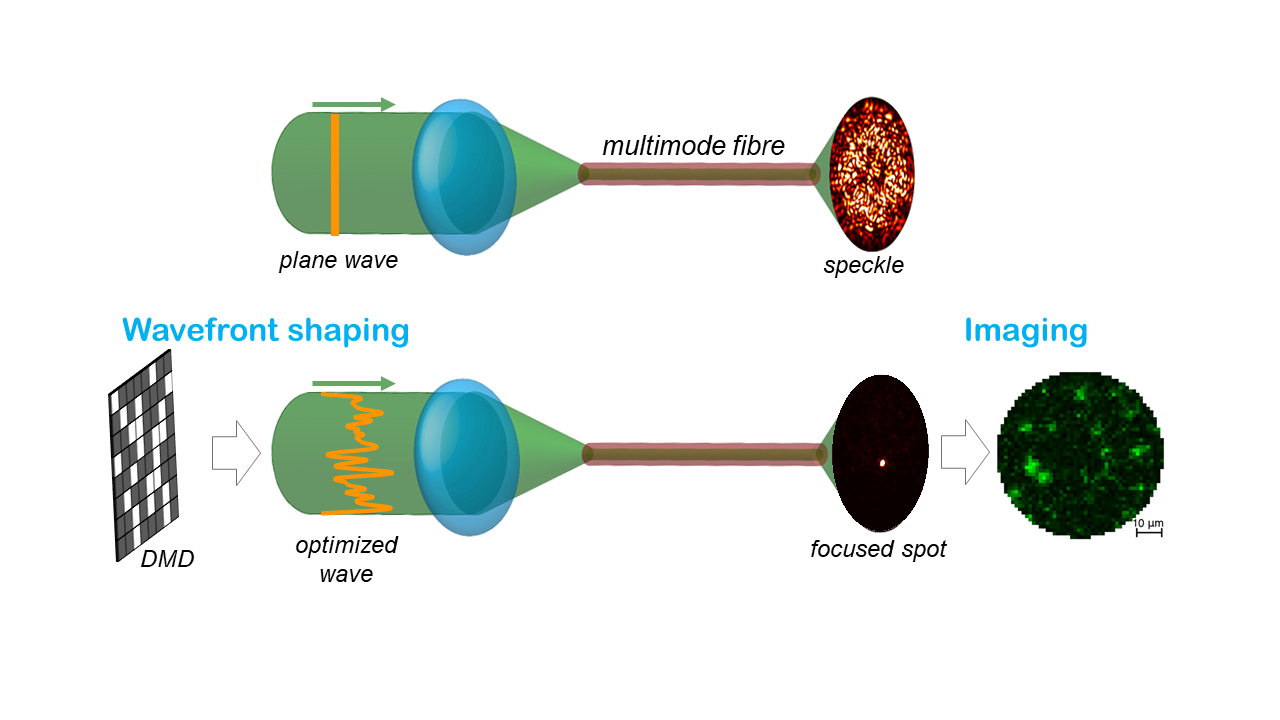- Share
- Share on Facebook
- Share on X
- Share on LinkedIn

Many applications for microendoscopy, such as brain imaging, require the development of thin probes to minimise damage during insertion in tissues. Multimode fibers (MMFs) are interesting candidates as they carry a large amount of information with a minimal footprint. However, light is scrambled during propagation in these fibers, so that the output pattern is speckle-like. Approaches based on wavefront shaping have been used to precompensate for this disorder, they usually require a pre-calibration of light propagation through the fiber.
In the team, we developed a single-fiber microendoscope combining photoacoustic and fluorescence imaging, which allows one to get absorption and fluorescence information with a single device. We are presently investigating applications of these endoscopes for non-destructive testing of industrial components, in particular, aiming at side-view endoscopic imaging inside control wells drilled through multilayered materials for the electronics industry.
Since calibrated-based approaches are unpractical for biomedical applications, we also develop calibration-free approaches: we have demonstrated a translational optical memory effect in square-core MMFs, revealing that the symmetry of these waveguides causes speckle patterns to shift in four directions at the output for any given input shift. Building on these results, we have then employed this memory effect for imaging purposes, enabling fluorescence imaging through square-core MMFs without requiring one to calibrate the fiber. This new imaging modality is more robust to fiber deformation as compared to state-of-the-art approaches based on transmission matrix measurements, thereby opening up interesting perspective for in-vivo endoscopic imaging. We will further investigate this memory effect, both theoretically and experimentally: currently, we do not know what limits the extent of the optical memory effect to typically 10 µm for fibers with core size around 100 µm, and a better understanding is needed to design fibers with an improved field-of view. The sensitivity of the memory effect to fiber deformations such as bending and twisting will also be studied. Theoretical investigation will be performed in collaboration with Dr. Davide Bucci from the CROMA (Grenoble INP - UGA), who developed a simulation tool based on RCWA (rigourous coupled-wave analysis).
References:
-
S. Mezil, A. M. Caravaca-Aguirre, E. Z. Zhang, P. Moreau, I. Wang, P. C. Beard, and E. Bossy, Single-shot hybrid photoacoustic-fluorescent microendoscopy through a multimode fiber with wavefront shaping, Biomedical Optics Express, 5717-5727 (2020).
-
A. M. Caravaca-Aguirre, A. Carron, S. Mezil, I. Wang, and E. Bossy, Optical memory effect in square multimode fibers, Optics Letters 46, 19 (2021).
-
D. Bouchet, A. M. Caravaca-Aguirre, G. Godefroy, P. Moreau, I. Wang, and E. Bossy, Speckle-correlation imaging through a kaleidoscopic multimode fiber, Proc. Natl. Acad. Sci. U.S.A. 120, 26 (2023).
People involved
Emmanuel BOSSY
Dorian BOUCHET
Philippe MOREAU
Irène Wang
- Share
- Share on Facebook
- Share on X
- Share on LinkedIn